|
3/2006
vol. 44
Artykuł oryginalny
Współpacjenci jako źródło informacji medycznych u chorych leczonych na oddziale reumatologicznym
RU 2006; 44, 3: 134–138
Data publikacji online: 2006/06/26
Pobierz cytowanie
Introduction
Patient’s education is considered as an important component of a complex management of patients, especially those suffering from chronic disorders [1]. The education is considered to enhance knowledge of the patients that focus on better cooperation with the medical personnel. It includes understanding of general nature of the disease, recognition of early symptoms of exacerbation or adverse reaction of the medication as well as knowledge and motivation of introduction of proper changes in the patient’s life style [2]. Contemporary patients are getting medical information from various sources, and only some sources are at least partially controlled by medical staff [3]. It is generally believed that most of the patients admitted to hospital are willing to discuss problems of their diseases with other patients staying in the hospital. The discussions are probably a form of stress reduction and facilitate adaptation to a new situation, i.e. the hospital environment. Many physicians are convinced that changes in patient attitude (both positive and negative) towards a number of medical situations are resulting from information obtained from other in-patients [4]. To our knowledge, this phenomenon was never investigated. The present study was designed to evaluate the value and role of medical information obtained from other in-patients on patient’s behavior. Additionally, we would like to describe the potential factors that may affect the information transfer and application.
Patients and methods
One hundred consecutive patients fulfilling the inclusion criteria admitted to the rheumatological ward (summer 2005) were investigated. The inclusion criteria of the study were as the following: • patients staying in the hospital at least for 3 days • consciousness and full ability to converse • Polish language native speakers • informed consent for participants of the study. The following patients were excluded form the study • with coma, impaired consciousness, dementia or mental disorders, including depression requiring current pharmacotherapy • receiving medication known to affect consciousness, the use of sleeping pills to facilitate sleep was allowed • with disorders that did not allow them to leave the bed or to converse freely • with inability to write due to illiteracy or physical disability. All the investigated individuals were requested to answer the questions in the form of a questionnaire. The questionnaire was prepared for the study by the authors. It included 7 questions addressing the following problems: • attitude towards discussion with other in-patients • intensity of the discussions • the main medical problems discussed • impact of the obtained during the discussion information on the patient’s decisions related to diagnostic and therapeutic procedures. Additionally, the data on the patients’ education, duration of the disease symptoms and previous admissions to the hospital were collected.
Results and discussion
Table I summarized the characteristics of the investigated patients. It was found that 85 per cent of the patients were females and the most common age of them was over 51 yrs although almost the same number of patients was aged 31-50 yrs. It is similar to expectations and indicated that the investigated group was representative of the patients of our department. Educational profile of the investigated patients indicated that most of the patients had completed or uncompleted secondary education. A slightly lower number of patients had vocational education. About one-third of the patients were not admitted to the hospital in the one year preceding the investigation while two fifths of the patients were once or twice in the hospital within a year prior to the study. The declared will to discuss medical problems with other in-patients was summarized in Table II. The cumulative number of all the investigated patients who declared the will to discuss rarely and frequently seems to be similar, 48 and 37 per cent, respectively. Patients younger than 30 and older than 51 rarely discuss the medical problems. On the contrary, the patients aged 31-50 discussed with other in-patients more frequently. A relatively small number of male patients did no allow us to analyze the relationship of will to discuss in relationship to sex of the patients. In general, male patients less frequently discuss their problems while staying in the hospital. The value of the obtained data during the discussions between in-patients is showed in Table III. Almost half of the patients declared that the data obtained from other in-patients were useful for them, and had impact on their attitude to medical problems. A similar part of the patients indicated that the data were of low importance for them. This ratio was similar in all the investigated age groups. Female patients paid more attention to the data obtained from other in-patients as compared to male patients, although the number of investigated male patients was relatively low. There was no significant relationship of the patient’s education to the impact of the data obtained from other in-patients on the attitude to medical problems (Table IV). The obtained results should be considered as the preliminary study. The number of the investigated patients was relatively small, thus further studies are needed. The main observation indicates that almost half of the in-patients considered the discussion with the other in-patients a valuable source of information. This finding indicates the value of education and in some cases the origin of failure in compliance of the patients. The study was undertaken after a number of anecdotic observations indicating the progressive development of failure to glucocorticoid or cytostatic treatment during the stay in the hospital. Despite the discussion of the therapy with the patients, they suggested that they had “own” observations and sources of information. We had a feeling that some of in-patients spread “tragic” vision of sequels of the management. We had also suspicions that after such discussions between the patients the level of compliance was lower that before despite the efforts of the medical staff. The obtained results supported previous suspicions of mutual „education” of the in-patients. On the basis of the results it is difficult to conclude what factors are essential in this spreading of information. The most common “debaters” are female patients younger than 30 or older than 51. Education seems to have a small effect on the will to discuss medical problems; it is rather the feature of the patient’s personality [5]. Similarly, educational level has no significant influence on the patient’s attitude to the data obtained from other in-patients. This is probably also related to personality and emotional state of the patient. Summing up, the discussion between in-patients modifies their attitude to medical problems and their compliance with therapy. These finding from the practical point of view suggested the role of medical staff controlled education offered to the in-patients during their stay in the hospital. On the other hand, the obtained results once again, supported the well-known role of patient’s education in the comprehensive management of chronic rheumatic disorders.
References
1. Neame R, Hammond A, Deighton C. Need for information and for involvement in decision making among patients with rheumatoid arthritis: a questionnaire survey. Arthritis Rheum 2005; 53: 249-55. 2. Schrieber L, Colley M. Patient education. Best Pract Res Clin Rheumatol 2004; 18: 465-76. 3. Riemsma RP, Taal E, Rasker JJ. Group education for patients with rheumatoid arthritis and their partners. Arthritis Rheum 2003; 49: 556-66. 4. Barlow JH, Cullen LA, Rowe IF. Educational preferences, psychological well-being and self-efficacy among people with rheumatoid arthritis. Patient Educ Couns 2002; 46: 11-9. 5. Witney AG, Treharne GJ, Tavakoli M, et al. The relationship of medical. Demographic and psychosocial factors to direct and indirect health utility instruments in rheumatoid arthritis. Rheumatology (Oxf.) 2006 – in press.
Copyright: © 2006 Narodowy Instytut Geriatrii, Reumatologii i Rehabilitacji w Warszawie. This is an Open Access article distributed under the terms of the Creative Commons Attribution-NonCommercial-ShareAlike 4.0 International (CC BY-NC-SA 4.0) License (http://creativecommons.org/licenses/by-nc-sa/4.0/), allowing third parties to copy and redistribute the material in any medium or format and to remix, transform, and build upon the material, provided the original work is properly cited and states its license.
|
|

 ENGLISH
ENGLISH












